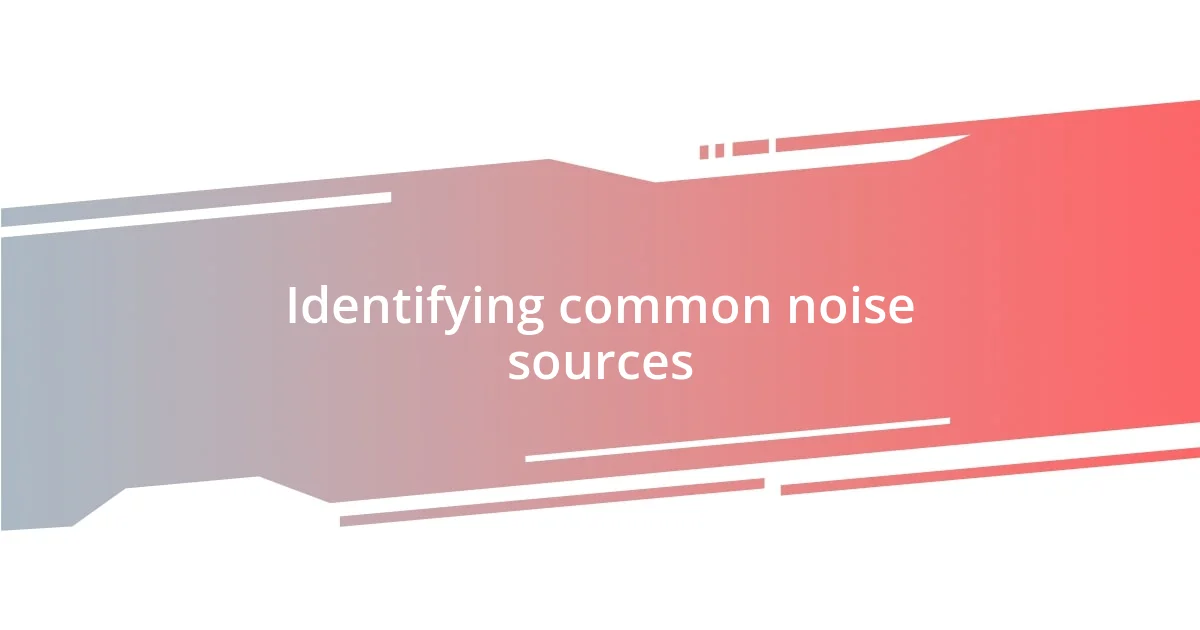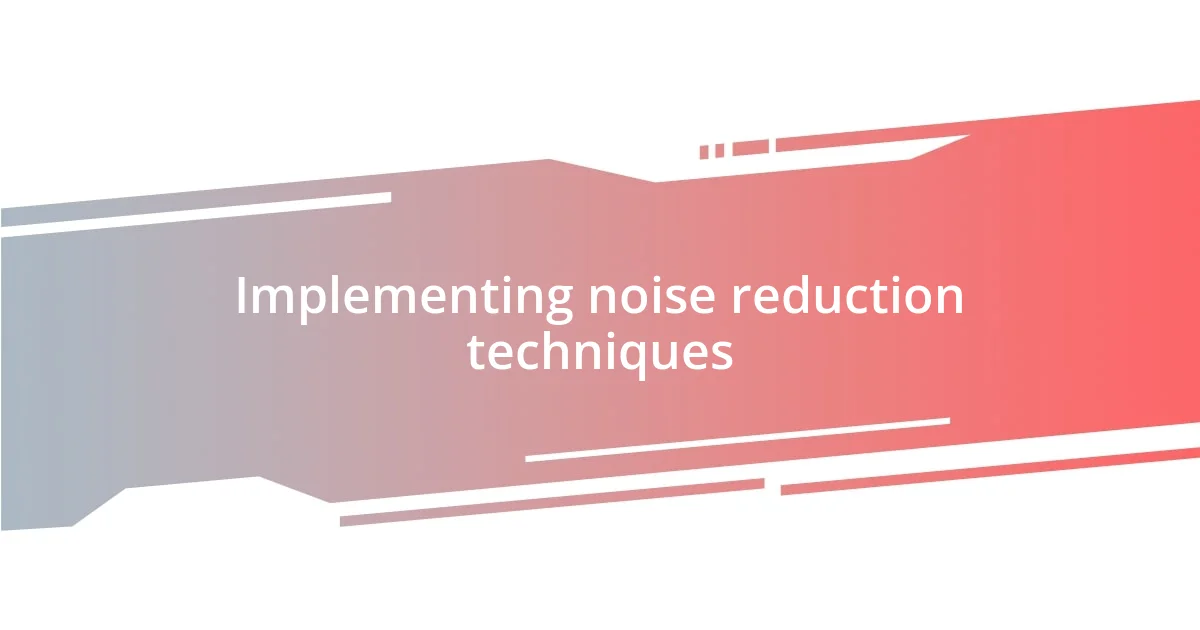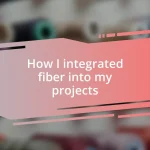Key takeaways:
- Understanding environmental factors, like moisture and temperature, is crucial for mitigating fiber noise issues to ensure data integrity and performance.
- Implementing proper cable management, high-quality connectors, and shielding techniques significantly reduces noise interference and improves signal quality.
- Continuous monitoring and documenting solutions fosters a collaborative team environment, enhancing collective problem-solving and knowledge sharing in fiber optics troubleshooting.

Understanding fiber noise issues
Fiber noise issues can often feel like an invisible enemy in data transmission, right? When I first encountered it, the frustration was palpable. It can disrupt signals in a way that leaves you scratching your head, questioning everything from installation methods to environmental factors.
I vividly remember a project where fibers laid alongside heavy machinery were causing distortion. The noise compromised our data integrity and slowed down operations significantly. It’s a stark reminder that understanding the potential sources of noise—like crosstalk and attenuation—can profoundly affect performance.
Moreover, I often ask myself: how much do we really consider the environment where we lay our fibers? The truth is, even small factors like moisture or temperature fluctuations can introduce noise. By delving deep into these aspects, I found a clearer path to mitigating the issues and improving overall reliability.

Identifying common noise sources
Identifying common noise sources in fiber optics can be quite the eye-opener. I once worked on a project where electromagnetic interference (EMI) was a continuous headache. I distinctly remember the moment we realized that nearby power lines were wreaking havoc on signal clarity. It taught me to pay closer attention to environmental factors that might seem innocuous but can significantly impact performance.
Here are some common noise sources to consider:
- Electromagnetic interference (EMI) from power lines and machinery
- Crosstalk between adjacent fibers or cables
- Temperature fluctuations affecting signal integrity
- Moisture and humidity contributing to attenuation
- Improper installation techniques leading to physical strain on fibers
These insights helped me uncover issues I might have otherwise overlooked. Understanding these common noise sources not only alleviated my initial frustrations but also empowered my team to implement better solutions.

Assessing fiber performance metrics
Assessing fiber performance metrics requires a keen eye on various factors. When I first tackled this, I realized how vital it is to evaluate metrics like latency, bandwidth, and signal-to-noise ratio. One time, I was part of a team expanding a network in an older building. We discovered that our latency was significantly higher than anticipated. After some investigation, I learned that the older fiber wasn’t up to par with newer standards. This moment taught me that keeping track of performance metrics can save you from costly surprises.
In my experience, signal-to-noise ratio (SNR) directly influences overall fiber performance. I remember analyzing a project where we frequently lost connection during data transfers. Upon evaluating the SNR, we found that it was well below acceptable levels due to aging cables. Adjusting our fiber installation strategy significantly reduced dropouts and boosted productivity. It was a rewarding experience that highlighted the importance of regular performance assessments.
Another critical aspect to consider is bandwidth, which directly affects user experiences. While working on a broadband upgrade, I noticed that our users consistently reported slower speeds during peak times. By reviewing our bandwidth metrics, it became clear that our infrastructure was overwhelmed. After upgrading to higher-capacity fibers, we observed fantastic improvements. This transformation was especially gratifying for both users and my team.
| Performance Metric | Description |
|---|---|
| Latency | Delay in data transmission, measured in milliseconds (ms). |
| Signal-to-Noise Ratio (SNR) | Ratio of signal power to noise power, indicating clarity. |
| Bandwidth | Data transmission capacity, typically measured in Mbps or Gbps. |

Implementing noise reduction techniques
When it comes to noise reduction techniques, one approach that I’ve found particularly effective is proper cable management. I vividly recall a project where chaos reigned supreme because cables were tangled everywhere. Not only did this create physical strain on the fibers, but it also allowed for crosstalk, which steeply degraded our signal quality. After implementing a meticulous cable routing strategy, I could almost feel the sigh of relief from the entire team as connections stabilized and performance metrics improved.
Another technique that really struck me was the importance of using high-quality connectors and splice points. I remember a time when we faced constant interruptions during data transfers, and after some investigation, we discovered that our connectors were the weak link. Upgrading to premium connectors not only enhanced connectivity but brought about a noticeable drop in signal loss. Have you ever wondered how something so small could wield such power? It made me appreciate the details we often overlook in our pursuit of perfection.
Finally, shielding your cables is an often-underestimated noise reduction technique that I personally advocate for. On one project, we had to run cables exceedingly close to heavy machinery, and the interference was palpable. By investing in shielded fiber options, we shielded not just the cables, but also our sanity. It was an eye-opening revelation to see just how effective this simple upgrade could be. Seeing improved signal integrity unfold felt like a win on so many levels—both for the infrastructure and for my peace of mind.

Utilizing advanced testing equipment
Using advanced testing equipment is indispensable in pinpointing noise issues in fiber optics. I remember during one particular project when we implemented an Optical Time-Domain Reflectometer (OTDR). This device allowed us to analyze the cable’s integrity over long distances, revealing not just breaks but also areas of excessive loss. The satisfaction of visually mapping the performance while uncovering problems in real time was invaluable.
In another instance, I utilized an optical power meter along with a light source to assess the power levels in various segments of our network. The measurements revealed unexpected fluctuations caused by external interference, a fact that might have gone unnoticed without this advanced equipment. Have you ever experienced that moment of revelation when data validates your suspicions? It was a gratifying experience to refine our strategy based on that tangible evidence.
Finally, leveraging a spectrum analyzer opened my eyes to the complexities of frequency interference. During a testing phase, I noticed certain frequencies were congested, impacting our overall bandwidth. Adjusting our channel allocation based on these findings improved our signal quality remarkably. That experience underscored for me the critical role that advanced testing tools play; without them, I’d hate to think how much time and resources could have been wasted chasing shadows.

Monitoring results and adjustments
Monitoring results and making adjustments is crucial in addressing noise issues in fiber optics. I vividly recall a time when I was monitoring the performance of a newly installed system and noticed persistent anomalies in the signal quality. It struck me how imperative it was to stay attuned to these nuances, so I took prompt action, recalibrating the settings based on real-time data. It was like detective work—every little change I made felt like a step closer to resolving the mystery.
While observing the results, I often found myself reflecting on the need for constant vigilance. I remember one instance where even minor fluctuations in temperature had a significant impact on the signal. This experience taught me the importance of not just collecting data, but actively engaging with it. How often do we accept fluctuations as the norm? In my case, it was rewarding to recognize the patterns in our measurements and adjust our strategies accordingly.
Notably, implementing feedback loops made a world of difference. After recording numerous performance metrics, I’d often share my findings with the team, inviting input on possible adjustments. One collaborative meeting led to a breakthrough—we pinpointed an external factor contributing to our noise issues. It reminded me of the power of teamwork; sometimes, a fresh perspective is all it takes to illuminate a path forward. Each adjustment we made not only resolved specific issues but also fostered a sense of ownership and pride within our group.

Documenting and sharing solutions
Documenting and sharing solutions is a vital part of troubleshooting noise issues in fiber optics. I remember after resolving a persistent interference problem, I created a detailed report outlining our methods and outcomes. This wasn’t merely for record-keeping; it was my way of ensuring that the lessons learned could benefit others on the team. Have you ever felt the pride in knowing your experience can prevent someone else from facing the same challenges? That sense of community drives me to share my solutions actively.
Additionally, I found that hosting a debrief session after critical projects allowed us to discuss our findings more openly. One time, we gathered after addressing a particularly confusing bout of signal degradation. As we shared our experiences and the remedies we employed, it felt like a mini-revelation. I realized that each person’s input illuminated aspects I hadn’t considered. Sharing those insights forged stronger connections within the team and cultivated a culture of problem-solving that extended beyond any single issue.
I also began to leverage digital platforms for documenting our solutions. I recall setting up a shared drive where we could upload case studies of noise issues we encountered and how we resolved them. It was encouraging to see how quickly this resource became a go-to for both seasoned professionals and newcomers alike. Have you experienced the transformation that happens when knowledge becomes easily accessible? That’s what I strive for—creating an environment where everyone benefits from collective wisdom, thus enhancing our collective expertise in fiber optics troubleshooting.















